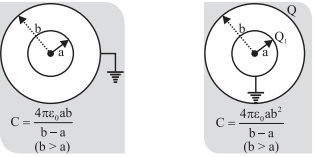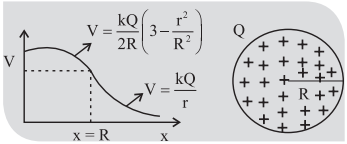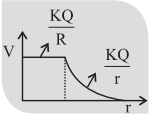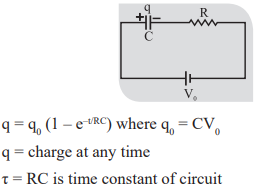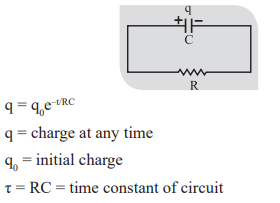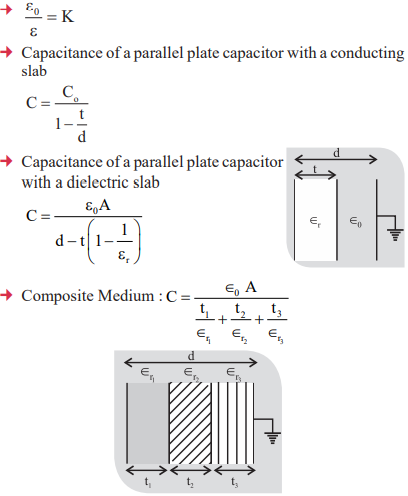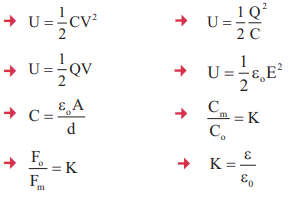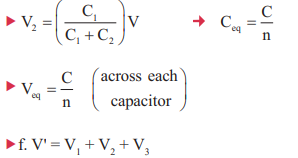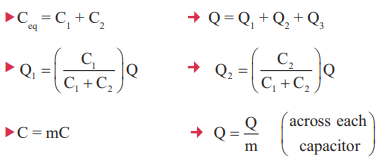Hi CUET aspirants, Welcome to Amans Maths Blogs (AMBIPi). In this post, you will get CUET Physics Electrostatic Potential and Capacitance Revision Notes AMBIPi. This CUET Physics Notes are designed by analyzing to the CUET Syllabus and CUET Previous Years Questions Papers.
CUET Physics Notes
CUET Physics Electrostatic Potential and Capacitance: Important Points to Remember
There are following important points in this chapter of Electrostatic Potential and Capacitance.
- Dielectric constant (K) of an insulator can’t be ∞.
- Two plates of unequal area can also form a capacitor, effective overlapping area is considered.
- If n identical capacitors are connected in parallel which are charged to a potential V. If these are connected in series then potential difference of combination will be nV.
- Capacity of earth is 711 μF. (C = 4πε0r) r = radius.
- Total energy stored in any set up of condensers is sum of the energies stored in individual condensers whatever be the mode of combination.
- Earth can be given almost unlimited charge because its capacity is very large.
- To store charge and energy is the basic use of capacitor.
- An equipotential surface is that surface, at every point of which electric potential is the same. Equipotential surface are always perpendicular to the electric field lines.
- Introduction of dielectric slab in between the plates of a charged capacitor with battery connected across the plates:
(i) Potential remains constant,
(ii) Capacity increases,
(iii) Charge increases,
(iv) Energy increases
(v) Electric field decreases - Introduction of dielectric slab in between the plates of a charged capacitor with battery disconnected across the
plates
(i) Charge remains constant,
(ii) Capacity increases,
(iii) Potential decreases,
(iv) Energy decreases - Dielectric are of two types (i) Non-polar (N2, O2, He etc) (ii) Polar (H2O, CO2, NH3 etc)
- Capacitance of a Spherical conductor C = 4π∈0∈rR in a medium C = 4π∈0R in air.
- Special Capacitor
CUET Physics Electrostatic Potential and Capacitance: Important Graphs
1. Electric potential due to a spherical shell of uniformly distributed charge with surface charge density σ.

2. Electric potential due to a solid sphere of uniformly distributed charge with volume charge density ρ.
3. If after charging the capacitor, the source of constant potential difference is disconnected and the charged capacitor is shorted through a resistance ‘R’, then by Kirchhoff’s law, at time ‘t’ from the instant of shorting,
4. In a hollow spherical shell, potential (V) change with respect to distance (r) from center is
CUET Physics Electrostatic Potential and Capacitance: Important Formulas
1. Attractive force between capacitor plate
2. Charging of a capacitor
3. Discharging of a capacitor
4. Capacitance, Parallel Plate Capacitor
5. Cylindrical Capacitor, Spherical Capacitor
If n drops gets combined to form a big drop then
Charged on the big drop (q) = nqo
Capacity of the big drop (C) = (n)1/3 Co
Potential of the big drop (V) = (n2/3) Vo
Potential energy of the big drop (U) = (n)5/3 energy each (Uo)
q = CV
6. Insertion of Dielectric Slab Inside the Capacitor, Energy Stored
7. When two charged conductors of capacitance C1 & C2 at potential V1 & V2 respectively are connected by a conducting wire, the charge flows from higher potential conductor to lower potential conductor, until the potential of the two condensers becomes equal. The common potential (V) after sharing of charges:
(i) When the positive plate of one connected to positive plate of other then common potential.
(ii) Charges after sharing q1 = C1V & q2 = C2V. In this process energy is lost in the connecting wire as heat.
(iii) This loss of energy is
8. When positive of one with negative of other then common potential
9. After connection ratio of charge would be in ratio of capacitance
10. Series Grouping
11. Parallel Grouping
CUET Physics Mock Test
Now, you have revised the this CUET Physics chapter. So, you must need to practice CUET Physics Sample Papers. By solving these CUET Physics questions, you will be more confident about your CUET preparations.

